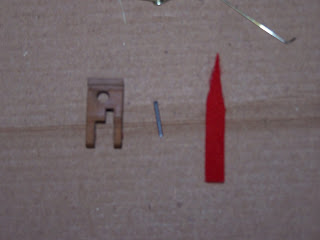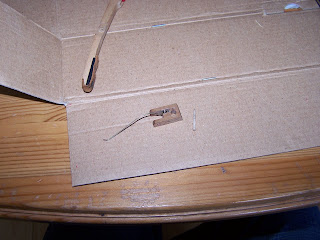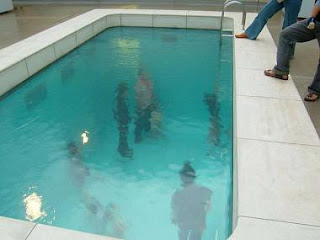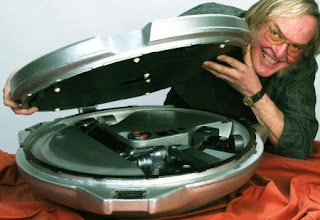
Sunday, July 06, 2008
Saturday, July 05, 2008
DIY Upright Piano Repair #1 - Replacement Damper Spring
I payed £20 for this thing, which isn't bad I don't suppose, but because of its age (dates back to 1915) I've had a number of recurring problems with it - mainly down to the age of some of the internal action components.
So, says I - instead of wanting to spend £25 an hour for a piano tech. to come out and fix it every time something relatively minor happens, I shall learn how to do a few DIY repairs of my own. I then thought that because it's sort of interesting how pianos work, and probably not many people know how to make simple minor repairs to them, I should document my little voyage of discovery on this blog, in case it's of interest to anyone else out there.
Please note that I am not a piano technician of any kind, and usually have about as much DIY skill as a chimp in boxing gloves. The motivation behind ripping my piano to bits is basically twofold: 1) I think it's always a good idea for a musician to understand the mechanics of the instrument they play and 2) I'm too tight to fork out a couple of G's on a decent piano right now, so I'm stuck with the purple thing for a while. (I've actually grown quite fond of it). If you foolishly decide to follow any of the procedures put down here you get yourself into trouble and screw up your piano - then tough, it's at your own risk.
Right then, to the first simple repair.
A common enough fault with old pianos is that damper springs break due to fatigue and age.
To explain what this means briefly: when you hit a key on an upright piano, a push rod (connected through a number of wooden moving parts - I'm not going into the basics of a piano action here) connected to the far end of the key moves up, throws a hammer forward onto the string whilst at the same time pulling back a damper (which normally rests against the string in a steady state scenario - i.e. piano at rest) so that the impact of the hammer against the string causes a note to be heard.
When you relieve the pressure on the key (let it up) the damper springs back against the string in order to stop the string ringing. This is pretty intuitive - we've all plonked on a piano, and as long as you hold down a key, the string will ring - until of course natural decay causes it to fade away. If you release the key earlier, then the sound is cut off abruptly. This is what dampers do.
Now, in order for the dampers to spring back onto the string, they are springloaded with a damper spring, and there is one for each and every key on the piano. (88 keys in the case of most uprights). If the damper spring fails, then the symptom is that a given key (the one associated with the damper) will just continue ringing after you've release pressure on the key. This normally makes the piano fairly unplayable - because every time you hit the offending key, the note associated with that key keeps ringing and causes some fairly horrible modern jazz effects.
Replacing these springs is fairly straightforward.
Here's a step-by-step procedure that I used to do this. Note that some of the photos don't look too good at the size they appear on the page. Just click on any one of them to get a full resolution version!
Step 1. Remove the front of the piano, so that the action is exposed.
This should be pretty easy - but will differ from piano to piano I guess. In the case of mine, it involves flipping up a flap at the top of the piano, and reaching inside to release a catch that holds the front face of the piano in place. Once, you got this panel removed, you then also need to remove the fallboard and nameboard (the bits of wood resting on top of the keys and which will normally have the key lid attached). On my sheddy old piano, these bits just slot out without any latches needing undoing.
Step 2. Lift out the action.
Once you can get at the action, you need to lift it out of the piano very carefully and rest it somewhere stable and clean so that you can get at the individual damper assembly that you want to work on.
On my piano, the action is held in place by two little catches on either side, where the action block slots into the main piano frame.
Once these latches are undone, you (I think this is fairly standard on most sensible uprights) tilt the action forward (towards you) and then lift it out. Note, that you should check both sides of the action for connecting rods (dowels) coming up from the pedals. I think that you're actually supposed to disconnect these first, but if you're careful (or don't care about breaking stuff like me) then you should be able to get the action out without needing to do this.
Once you have the action out, you'll be able to see it in all it's glory - but remember most of this stuff is just made of wood and therefore fragile. Don't start hitting it with a hammer just yet.
Step 3. Remove the Damper Arm Assembly
Before you can replace a damper spring, you need to remove the damper arm assembly in question from the main action chassis. This is straightforward and simply a matter of locating and then unscrewing the screw that holds the assembly in place - by way of a damper flange which is a little block of wood with two tongues, that has a center-pins running through it at various points in order to allow free pivotal movement of the various damper components.
If you look at where the flange connects to the damper arm, you will see that there is a small center-pin holding the arm in place, between the arms of the flange. Depending on where the damper spring has broken, then you probably want to detach the arm at this point, so that you can get at the spring seat to remove the "hoop" of the old spring. Basically, you need to strip the assembly down.
 Damper flange removed, you can see the arms where the damper arm slots in and the small recess for the seating the spring base. In this photo the center pin holding the arm to the flange is see to the right of the flange.
Damper flange removed, you can see the arms where the damper arm slots in and the small recess for the seating the spring base. In this photo the center pin holding the arm to the flange is see to the right of the flange.To detach the arm, very, very carefully push out the center-pin holding it in place with a center-pin pusher or a very thin gauge center-pin punch. If you can, try and do this without ripping and shredding up the cloth bushing that will surround the center pin. As I've mentioned I'm very cack-handed and not generally any good at this sort of manual stuff, but I found that just being very patient and being very gentle seemed to do the trick. (Think of it like an airfix model).
Step 5. Remove the old spring remnants.
Turn the flange side on, and look at how the damper spring is held in place. You should see a thin line of chord pulled through the sides of the flange and through the eye of the spring, and normally the spring will have a little heel inserted into a hole in the flange recess. Using a pair of tweezers (my wife's eyebrow ones are the ones I used) pull the chord out and then snag out the remains of the old spring.
If you shred the cord (it may be well worn out), then you will need to a narrow (about 1 - 1.5 cm) replacement strip of chord - if not, then you can re-use the old one. (Which is what I did). Keep this chord for the next step.
Step 6. Set the new damper spring.
Making sure that you have the flange oriented the correct way, slot the heel of the spring into the hole in the flange recess, and then wet the chord and pull it through the flange and the eye of the spring so that you end up with something like that shown in the photo below:
 New spring in place, almost there.
New spring in place, almost there.To make sure you have things the right way around, place the flange on a flat surface, with the edge that connects to the piano facing down. (I.e. as it would sit back in the action frame). Check that the spring forms an arc out of the flange so that it looks like a kids slide. It should be convex in aspect, and not concave. If it is the incorrect way around, then remove the chord, switch the spring around and then re-seat it.
Note - I put a tiny blob of glue at each end of the chord to hold it in place, just to prevent any lateral movement as the spring works back and forth whilst playing the piano. Not sure if this is good or bad practice, just seemed logical to me.
Step 7. Re-attach the damper arm.
Once you're happy with the spring, then re-attach the flange to the damper arm by pushing back in the center-pin (again - very carefully) and then position the spring so that the curved tip at the top of the spring is seated on the felt pad situated about 3/4 of the way up the back of the damper arm. The finished damper arm assembly should look like this:
 A finished damper arm assembly, with replacement spring firmly in place. Wife's tweezers can be seen at the top right of this photo.
A finished damper arm assembly, with replacement spring firmly in place. Wife's tweezers can be seen at the top right of this photo.One thing I noticed here was that the replacement damper springs which I bought were slightly narrower in gauge than the one which I replaced. Because of this, the spring wouldn't seat exactly in the middle of the damper arm. A bit of gentle tweaking with some electrical pliers sorted this out - however if you do this I'd be careful not to weaken the spring by being too rough with it. I think that the main thing you're looking for is that top of the spring moves smoothly over the felt pad (red blob in the picture above) as the arm moves, so that you have a nice seamless action to the assembly.
Step 8. Re-seat the damper arm assembly in the action.
Once you've admired your handiwork for quite some time, as I did - I can tell you, you then need to put the damper arm assembly back into the main action chassis. Hopefully at this point you will remember where it came from, and so re-attaching it is really just a matter of seating the flange against the main action rail (which is the long piece of wood to which all the damper flanges connect).
Be extremely careful here not to over-tighten the flange screw. If you do then you can quite easily strip the thread and have to do some drilling, plugging, doweling and allsorts in order to make good.
The best strategy is to screw things back in quite lightly, and then once the action is back in the piano tighten up a fraction in order to align the damper arm correctly with it's target string.
Step 9. Put the action back into the piano, check alignment.
Nearly done. Carefully, place the action back into the piano, flip the catches to hold it in place (its final resting place) and make sure that the connecting dowels to the pedals are seated on the various rails correctly.
Once the action is back in, stoop so that you're eye-level with the damper that you've replaced the spring on, and press down the key it's connected to a few times. Visually check that the damper is still moving forward onto the correct string in a nice, straight alignment. If it's veering over to one side or the other, then either loosen or tighten the damper flange screw (as in Step 8) a tiny bit so that the arm moves to the left or right. By gentle, and don't rush any tightening or loosening of screws.
Step 10. Put the covers back on.
Slot the various bits of panelling back onto the front of the piano - and voila, a simple DIY piano repair finished in under an hour.
As I mentioned before, I'm not a trained piano tech. or anywhere even close, but hopefully someone might find this useful somewhere, or perhaps someone who actually knows what they're talking about can drop a few comments in to help out with a few tips.
N joy.
Friday, July 04, 2008
Boob Couture #2
Wednesday, July 02, 2008
A Country Gent's Cockney Rhyming Slang Primer - Part 1

Little Bo Peep - a sheep
Example Usage: "I say Morty, isn't that fine looking Bo Peep over there?"
Roger Melly - a welly
Example Usage: "Blast! Where did I put my Roger's?"
Bowl Me Over In The Clover - Land Rover
Example Usage: "I'm off for a trundle in my Clover - back soon, in time for crumpets and Pimms".
Terrence Stamp, an Actor - Tractor
Example Usage: "Damn it if my leg isn't trapped underneath this God awful Terrence"
Rubber Band - Farm Hand
Example Usage: "We'll need a few more rubbers before taking on that meadow, I fancy".
Incidentally....Uselessly Crap Fact Alert
The correct spelling translates from French to English as something like "high sewing", to reflect the precision craft involved in sewing together dead badgers, Dalmations etc...in order to reach a sublime level of fashion achievement.
"Haute coiture" on the other hand, could be taken to mean "high copulation" taking the "Haute" from the French and the fact that "coiture" is actually an old synonym for "coitus" - i.e the act of copulation.
Think on, and take care to enunciate correctly next time you run into Gok Wan down at the local bridalware emporium...you don't want him getting the wrong idea.
Boob Couture
 I've just ordered a rather dashing T-shirt (design on the left) for my better half from the following web-site:
I've just ordered a rather dashing T-shirt (design on the left) for my better half from the following web-site:http://www.itiswhatitis.co.uk
How funny is that? They have a nice selection of both mens and womens T-shirts, definately worth a look. Very helpful as well, I was online at about 11pm last night and managed to get responses to a few queries within minutes. Not bad at that time of night for a UK-based firm, where most people would either be A) sipping their Horlicks and spanking their monkey or B) down the boozer getting lashed.
Of course, I haven't received the T-shirt yet so I might have to take all this back - but I'm reasonably confident they're going to come through for me.
Money well spent. :-p
A Cool Little Laptop Gadget
 I've just purchased one of these handy little laptop cooling plinths from Amazon for the best part of £30, (which ain't bad) so that I'm no longer able to fry eggs on the underside of my lappie chassis.
I've just purchased one of these handy little laptop cooling plinths from Amazon for the best part of £30, (which ain't bad) so that I'm no longer able to fry eggs on the underside of my lappie chassis.I've only been running with it for about 2 hours or so, but I'm already quite impressed. the underside of my laptop is now "touch safe" and fingers don't get welded to any exposed metal surface. Also, given that the cooler has a forward-tilted design, it actually leads to a much more comfortable typing position. (I normally just have my laptop laid flat on a table).
Most modern laptops that have any serious GPU, CPU components built-in suffer from some bad intermittment performance characteristics due to thermal effects, but since applying the cooler (I'm not sure if I'm just imagining this) but my performance appears to have been much more stable - even whilst running multiple VMWare images in parallel. I'll post again on this in a couple of weeks once I've had chance to monitor the core temperatures for a longer period of time.
Installation was as easy as it could be - just plonk your laptop on top of the cooler, connect the cooler to a spare USB port (it drains power from the USB bus so no need for a separate power supply) and away you go. It also has a built in 4-port USB hub which is handy - prevents getting the usual rats nest of USB cables if you've attached multiple devices in this way. (I have mouse and two external HDD's). The sound levels are very quiet as well - quieter than the standard Dell built in fan (I have a fully-loaded D830 running Ubuntu Hardy Heron), which incidentally hasn't been running at all since the cooler was switched on.
I'll see what it's like for reliability over the next couple of weeks, but so far - as I say, I'm impressed.
Nice gadget.
Sunday, June 29, 2008
Haven't Got A Scooby Who...
Ok, ok so I know that Dr. Who is supposed to be for kids (and I guess tank-top wearing middle-aged trainspotters) and has built a reputation on scaring the pants off generations of them with aliens constructed out of nothing but surplus Noel's Houseparty Gunge and used bog rolls - but come on, last nights' episode was really scraping the bottom of the barrel. There were a number of things that I thought were particularly bad about it, here's a bit of rant on a couple of them...
Daleks. God I hate Daleks. You'd really think that the Dr Who team could come up with something at least mildly original for a series finale. Instead, what do they do? They do what they've already done countless times in the new bunch of Dr. Who episodes and "bring back the Daleks". Again. Why? Daleks really are the most ludicrous, least menacing arch-nemesis ever dreamt up in the history of B-rate science fiction. Worse than the Triffids and that's saying something. Do the Dr. Who writing team have any fresh ideas?
 Daleks - apparently the most nefarious, evil, human-hating scum in the Universe. A nasty paper-cut would probably be worse than a run-in with one of these mechanical dog-crap receptacles.
Daleks - apparently the most nefarious, evil, human-hating scum in the Universe. A nasty paper-cut would probably be worse than a run-in with one of these mechanical dog-crap receptacles.To start with, you have the usual objections to the Daleks. They couldn't historically get up stairs without the aid of a Stanna stairlift for starters. For seconds, they move at the pace of a disabled turtle on the ground - you could outrun them in a Lada. Of course, the script writers have "cunningly" got around these things in the more recent series by using CG to provide them with rather naff-looking anti-gravitation devices or something similar, so that they can fly and whizz about looking like rampant arial wheelybins of destruction.
In addition, they're thick and just plain improbable. Thick, because they have an extremely limited vocabulary, ("EXTERMINATE!", "THE DOCTOR" etc...) which to my mind is a sure sign of some form of retardation as opposed to vastly superior technological knowledge as the script writers would have us believe.
Improbable, because they apparently build all this fabulous technology to enslave whole planets with, but just what do they build this stuff with then? Their little sink-plunger attachments? Detailed electronics work with a sink-plunger? That's like getting a horse to cook an omelet. C'mon chaps. Give the viewer some credit.
 Early Dr. Who scripts cast the Dalek as an inter-galactic gigolo love-droid, until the writers realised that these metal miscreants actually have no todger, and less sex appeal than a wobbly shopping trolley.
Early Dr. Who scripts cast the Dalek as an inter-galactic gigolo love-droid, until the writers realised that these metal miscreants actually have no todger, and less sex appeal than a wobbly shopping trolley.I mean, if everyone's telling us they're evil and nasty then they must be, right? A really good, well written and really imaginative baddie would actually convey this to the viewer just through their presence and the plot logic behind their existence. Instead, with the Daleks, all the characters have to tell you how nasty they are, because if you (the viewer) were left to decide this for yourself you would probably be wondering what the big deal with them was. You might actually just find them a bit funny or a bit stupid really.
 Dr. "All Your Eggs In One Basket" Who. He's a single point of failure, and an unreliable one at that. He'd have been better off staying behind the counter in the menswear department.
Dr. "All Your Eggs In One Basket" Who. He's a single point of failure, and an unreliable one at that. He'd have been better off staying behind the counter in the menswear department.Also, all throughout the Saturday episode it was stressed how omnipotent the Daleks are - and yet, on two separate occasions both Rose and Captain Jack managed to blow the crap out a Dalek using a their spacy-looking guns. The obvious question is: if Rose and Captain Jack can waste a Dalek, then how come no-one else can?
Were all the soldiers in Torchwood with Martha Jones equipped with the hi-tech weaponary capable of taking the top off a Dalek? 'Course not - they had good, old fashioned machine guns and service pistols. How inconsistent is that? If the script writers of Dr. Who and associated spin-offs want us to have any kind of belief in their mythology, then they could at least try and make it a bit more logical and consistent.
I suppose they couldn't do this, because the only real bit of plot in the entire episode centered around the tension formed as a result of the doctors groupies not being able to find him (using a mobile phone of all things - groan) when the "Earth really needed him".
That whole aspect of the show was just laughable, and it's interesting to note how the Doctor has changed with the times as a character - from a bumbling slightly absent minded old man in the 60's, to some kind of Radio 1 super hero who can save the entire Universe from everything in the 00's. Everything that is, except from his haircut and possibly the Daleks.

To sum up, here's some of my own tips for the Dr. Who writing team:
- Read some proper science fiction, so that you at least have some idea of how it's supposed to be done properly.
- Retire the @#$%ing Daleks, they were probably scary for about thirteen seconds at some point in 1969, but they're just dated nowadays and don't really make any sense whatsoever.
- Try and come up with a consistent mythology upon which to base your scripts.
- Just because the show's about a time lord - don't overuse the whole messing with time thing as an excuse for flaky, tenuous plot lines that border on the pantomime.
- Put more Bernard Cribbins in the show. He's the only one worth watching. Perhaps you could re-create him as ruler of the Daleks or something.
Friday, June 27, 2008
Coming To A Tesco Near You Soon: Martian Asparagus
Phew.
I for one, am greatly relieved now that I know our asparagus stocks are safe well into the next century and beyond. If we can now just crack deploying a sustainable greenhouse on Mars, and of course a small branch of B & Q, we could move on to cucumbers and from there sort out all the worlds food problems.
 A Martian War Machine, seen here wielding an asparagus-tip Doomsday device. The prophetic nature of H.G. Wells' writing continues to astonish even today.
A Martian War Machine, seen here wielding an asparagus-tip Doomsday device. The prophetic nature of H.G. Wells' writing continues to astonish even today. Despite the deeply profound implications of discovering both water (in ice form) and alkaline soil - two key scientific finds which greatly increase the probability of indigenous lifeforms existing on our closest neighbouring planet; NASA decide to break the news gently through the use of fruit and veg metaphors.
 Early test flights of the Beagle 2 probe gave no hint or indication as to the abject and dismal failure that was to come.
Early test flights of the Beagle 2 probe gave no hint or indication as to the abject and dismal failure that was to come.The decision by the NASA publicity department to let some veg-obsessed "wet chemist" (check his department name) to talk to anyone about this makes even the Beagle 2 team look like sophisticated urbanites.
Think or Thwim
Although the pool still isn't quite finished, there's enough of it there - for instance a big hole with some water in it - to see that it should turn out to be a central attraction for the Conwy area, and further add to the facilities available within the area for swimmers of all ages, young and old alike. The internal layout of the building is modern, clean and has a definite feeling of space to it. Even the viewing stands seem to have a bit more leg room and perhaps more importantly - circulating air - than you typically find in other venues.
 The New Llandudno Swim Center - a number of local councillors and residents expressed concern that in the event of a severe flood in Llandudno, the building would be difficult to find due to it's "wave camouflage" design.
The New Llandudno Swim Center - a number of local councillors and residents expressed concern that in the event of a severe flood in Llandudno, the building would be difficult to find due to it's "wave camouflage" design.The only slight problem I noticed was that the car park (which incidentally, is "pay and display" and shared with Venu Cymru next door) was massively flooded last night - so much so that it looked as if they'd actually constructed a separate outdoor pool as part of the whole development.
They should probably sort out the drainage in the car park, if only to prevent any prospective customers from either 1) floating off whilst attempting to enter the building, or 2) returning to their car only to find it jacked up on a pile of dead crabs as a result of a bunch of marauding haddock stealing their tyres.
 Members of the Swim Wales governing body perform a spot-check inspection of tiling around the inside of the new Llandudno warm-up pool, only to find that the local Cosa Nostra swimming jamboree had been there earlier in the day.
Members of the Swim Wales governing body perform a spot-check inspection of tiling around the inside of the new Llandudno warm-up pool, only to find that the local Cosa Nostra swimming jamboree had been there earlier in the day.Other than this minor problem - which admittedly is still in keeping with the aquatic theme of the new building - it looks to me as if this was most definately 6 million clams well spent. I might even learn to swim myself.
Thursday, June 26, 2008
British Tennis Star Wins At Wimbledon...
Eye witness accounts cited here, here and here go on to explain how even though it seemed as if triumph was going to be snatched from poor Tim's hands at the last minute due to a strawberry in the winning match being obscured by a drop of hot chilli sauce, he gave everyone present a characteristically effortless performance by wiping away the offending condiment with a sleeve volley close to his baseline.
 The actual scratch card that propelled good old Tim to victory last night in Wimbledon Common. The proprietor of the 24 hour garage was said to be "underwhelmed and offended" by the performance.
The actual scratch card that propelled good old Tim to victory last night in Wimbledon Common. The proprietor of the 24 hour garage was said to be "underwhelmed and offended" by the performance.Well done Tim, keep up the good form we're all behind you for the 2012 Poker Stars Olympiad.
Extra Recycling Bins - Find Them Here!
Given that there are five of us in my household, and that we regularly run out of containers for the recyclable waste and other rubbish that we generate now that collections are done on alternate weeks, I decided to give this a whirl.
It was all easy enough, I simply completed the online form, and within a week a nice, shiny new recycling box was waiting for me as I returned home from a business trip down to London. Result.
I thought I'd pop this down on the blog because there are probably quite a large number of people in around the Abergele area that don't even realise that this is general council policy. (Also, I'm pretty desperate for things to write about as you can probably tell).
In fact, if you rummage around a bit more on their web-site you even find the statement:
You may request additional boxes and bags as you feel is necessary to enable you to recycle waste.Isn't that nice of the council? I think it is, and I also think that it shows their genuine committment to helping us all behave in a slightly more eco-friendly manner.
Of course, there's no telling how long this policy will stay in effect if everyone starts requesting extra recycling boxes and bags....but I guess there's only one way to find out. :0)
More information on all things council and in particular kerbside recycling can be found here.
Project Managers and Paper Bags
Over the past couple of years, or perhaps a little longer - myself and many of my colleagues have started to notice a fairly worrying pattern beginning to emerge within the IT sector; more specifically within the approach and organisation of medium-large software implementation projects.
It's simply this: the number of project managers within IT appears to be growing at an exponential rate, and the number of skilled staff that are actually capable of delivering anything tangible on a given project is in a reciprocal decline.
Whereas perhaps five years ago, when working through a deployment lifecycle on a medium duration/medium complexity project there might have been maybe one, possibly two project managers involved, my recent experience has been that for an equivalent project (even on the much smaller, tactical projects) I regularly have to liase with and bump up against anywhere up to about ten PM's in order to make any kind of forward progress at all.
To avoid any misunderstanding, let me clarify what (in this context) I mean by a project manager:
- Anyone that can't be seen to directly contribute to the project through the production of anything directly related to the delivery of the end product. (And that could be anything tangible such as documents, code, training etc...)
- Anyone that insists on only having a "high level" view of the various project elements.
- Anyone that appears to spend a great deal of their time dealing with "issues" and allegedly "managing risks".
- Anyone that has no apparent grasp of technical aspects of the project, and isn't a key business stakeholder affiliated with the project.
- Anyone from a non-technical background who attends a large number of meetings within the working week.
 Ideally, a strong PM should have the correct background for an IT project - not like Ralph here, who didn't realise until it was too late that in actual fact, a SAP workflow solution was required and not an extension to the local public toilets.
Ideally, a strong PM should have the correct background for an IT project - not like Ralph here, who didn't realise until it was too late that in actual fact, a SAP workflow solution was required and not an extension to the local public toilets.That's not all:
- IT project implementation costs are steadily on the increase, as the amount of money required to support superfluous project staff also increases.
- IT project implementation timescales are stretching, as more and more time is taken over pointless meetings and debates within entire clusters of non-technical project affiliates, for the sake of some weird form of self-fulfillment or self-aggrandisement. Often, key technical people are diverted away from productive work in order to attend such meetings, or to participate in such debates just in order to introduce some level of credibility to the whole charade.
- The number of key risks - which should be managed by this crew of project managers - is actually increasing in most projects due to poor communication and "chinese whispers" developing between and amongst them. (I could cite several examples where pretty innocuous events have been turned into deal-breakers as a result of this).
- Software-based solutions are consistently failing to meet requirements as a result of the previous three points, largely because of the fact that over-spend and poor project time-management ultimately result in feature reduction and requirements sidelining. It's a regular thing.
I personally think that there are a number of things going on:
- There is (and it's well documented) a genuine skills shortage within the IT sector, and the number of experienced, well-qualified technical staff to work on individual projects has dropped significantly over the past five or so years.
- There is an increase in the number of workers within the IT sector, but many of them lack the basic understanding of the fundamental principles behind computing and at a higher level, IT.
- Those people with little or no technical grasp of the subject matter are beginning to display aspirations to move into project management as a distinct, worthwhile career path. Without any formal technical grounding in the projects that they'd hope to manage. (It's like the old adage - "If you can't do, teach".)
- There is an decreasing lack of understanding at a business level as to what's involved in delivering any form of engineering project, of which IT projects are just a subset. For some reason, with the rise of the throway consumerist society it appears to be the normal expectation now that IT systems can be deployed simply with little real technical skill and knowledge.
- To supplement the lack of skilled resource (which has the net effect of driving up project cost and therefore commercial risk) companies have locked into this vicious cycle of employing more and more people in lower-middle management roles, to somehow manage this risk, without understanding that increased beurocracy leads to increased cost.
- Outsourcing of IT has exacerbated this whole thing, given that nowadays in large companies that have outsourced vast tracts of their IT delivery capability a larger part of project implementation time is spent fencing around the SLA (service level agreement) as opposed to actually getting anything done.
- Outsourcing has also (quite successfully unfortunately) managed to reinforce this belief that lots of lower-cost resource is better than smaller numbers of higher-cost expert resource. This is a complete piece of kiddology. Use of lower cost, high volume resource increases the management overhead on a project, decreases overall quality on a project and fundamentally stifles the innovation that needs to be present as part of the makeup of any successful solution delivery.
- The internal organisation and IT delivery capability within more and more private organisations is beginning to - through regulatory policy making and massively complex third-party supplier relationships - beginning to parallel the business model of the most inefficient organisational structures we know of: the public sector organisations such as those run by the government. (I'd love to hear from anyone that can credibly put up a strong counter-argument that these organisations operate at peak efficiency).

There is, of course a definite need for good, strong project managers on all but the most trivial of projects, and I'm actually honoured to work with a couple of people that succeed in turning project management into a real asset on a number of gigs. What I really find frustrating is this apparent wish to over-egg the whole management side of IT projects at present.
Is this just me, or does anyone else have a similar (or counter) viewpoint on the whole thing?
Wednesday, June 25, 2008
Thank You Orson Scott Card...

...for Enders Game. I've just read this for the second time after nearly twenty years and have to admit that it's an absolutely fantastic, seminal sci-fi work that inspires, is thought provoking and is a genuine joy to read.
I picked up a copy recently for my eleven year old son, who's a voracious reader and who's recently been keen to get into some sci-fi after pretty much reading most of the contemporary "young adult" fiction out there at the moment. Once he'd finished with it (and I have to say that he thought it was completely awesome and has since read the first two sequels Speaker for the Dead and Xenocide) I picked it up and worked my way through it in about a day.
For those of you that have never read it, then the basic plot is centered around the early years of Andrew "Ender" Wiggin as he is taken from his home and put through a military school (Battle School and later Commander School) with the sole objective to turn him into the perfect military leader, to help Earth overcome the forces of the (apparently) nefarious Buggers - an insect like race hailing from some far flung corner of the galaxy.
This book has a number of quite visionary elements to it in my opinion, and brims over with engaging and thought provoking ideas that really good sci-fi should always have. To name but a few of the ones that I found most interesting are:
- The idea of propagating "remote" war through the medium of simulated reality. Ender and his cohorts are trained over the years using rich simulated environments, not a million miles away from the kind of FPS and RTS games that have been evolving over the past ten years.
- The idea of a political, questionably democratic movement asserting itself through nothing other than the media networks and news channels. One of the sub-themes within the book is how Ender's brother and sister rise to have real political power as a result of them instigating of social change purely through the expression of their ideas on something very similar to the Internet as we know it today.
- The notion of homogenisation of nation-states into less granular super-powers and the alignment of these super states against opposing idealogical principles.
- What it means to be a killer and what it means to separate the consequences of an action from the initial intention of the action.
In other words, it strikes precisely the right balance between challenging the reader at the abstract, philosophical level but (if you want to take the whole thing a lot more literally and on face value) also allows even the most casual reader to enjoy a thoroughly good yarn with all the trademarks of strong character development, interesting and intriguing plot twists - the lot.
Thank you Orson Scott Card, for this fantastic and amazing novel.
UFO Across The Mersey
Not in itself particularly interesting thought I, until I watched the Flash vid associated with it and caught the snippet taken from de-classified MoD report regarding some blokes apparent contact with an alien life-form called Algar.
I for one, would like to be the first to offer my condolences for his great loss, with Algar being killed by another race of beings. Let's hope this doesn't cause some kind of inter-galactic war.
BTW, if you're interested in tracking down the original Algar report and other completely bonkers reports of lights in the sky, space cows, ray umbrellas and erm...visitations, then check out the National Archives page here.
Caravan Tax
If, like me you're fortunate enough to live in a scenic part of the UK then you're probably used to the periodic influx of caravans (and associated caravanners) that happens each and every bank holiday, school holiday break or sunny weekend.
They appear in their thousands like some weird invading army tugging their mobile lounges behind their oversized saloons or 4x4's, generally moving at no more than 50 miles per hour, clogging up not only the main arterial routes into a region, but also all the less-travelled A-roads and B-roads, back lanes and population centers. They get everywhere.
Local roads that you would normally traverse in a matter of minutes to get to your local amenities become clogged, glutinous affairs where forward progress becomes a source of intense frustration and stress.
With ironic names like the "Rapier", "Swift", "Valiant" or "Swallow" other road users are forced to sit behind these cumbersome, ugly contraptions as they make their ponderous way to the nearest herding point, so that their occupants can plug in their mains electricity, set up their satellite TV, crack open their chemical bog and get down to enjoying the thrills and exuberance of a truly nomadic lifestyle.
 The Avondale Land Ranger - a prince amongst caravans to some, just another white, wheeled coffin to others.
The Avondale Land Ranger - a prince amongst caravans to some, just another white, wheeled coffin to others.I'm not a fan, as you can probably tell. To me, caravans can be basically summed up as the "suburbs on the move". Each weekend, thousands upon thousands of people pack up their stuff, cram it all into a lounge on wheels with all the creature comforts that they would have in their own homes and hunt out specifically clinical, managed, safe resting places where they can set up camp and get down to enjoying what they would probably do if they were still in their lounge back home in good old Suburbia.
The popularity of caravanning in the UK is huge. Some statistics taken from the Caravan Club indicate that:
- There are currently approximately 1 million registered caravanners within the UK.
- The CC annual turnover is £95 million pounds, indicating a sizable market for "value add" caravanning services.
- The number of registered caravanners more than doubled (from 100,000 to 250,000) between the years of 1971 and 1982.
- That caravanners inject somewhere in the region of £370 million pounds a year into various regional ecomonies.
- There is on average, one CC badged caravan site for every 30 square miles of country within the UK.
As I was sitting in my car on the A55 the other day (incidentally stuck in a jam caused by an overturned caravan) it occurred to me that I've never seen (and admittedly not really actively gone looking for) any kind of lobbying asking for a degree of taxation to be applied to the use of caravans. It hit me in a flash what a genius idea this would be. My rationale is simple:
- Caravans have the aerodynamic profile of a melted blancmange, and so vastly increase the fuel consumption (and therefore emissions) of the vehicle towing them to their final destination.
- To tow a caravan, you need a fair degree of torque, which generally you only get with larger, thirstier and dirtier engines, such as those found in the 4 x 4 models - often diesels.
- Towing a caravan dramatically reduces the fuel efficiency of the towing vehicle, and so lead to an increased consumption of diesel, petrol - driving up demand and so the forecourt fuel prices.
- Caravans are slow and directly cause congestion on many of the UK roads, resulting in jams and therefore driving up the emissions from vehicles of other road users; given that they end up having to sit around for longer periods with their engines running, in lower gears. Given the current governmental policy around road tax and linking it to emissions, this also has the indirect effect of driving up the cost of road tax for other road users.
- Caravans add either 50% or 100% the number of axles bearing down on the road (taken with those connected to the towing vehicle) and so must increase and/or exacerbate the wear and tear of the highways, thereby indirectly driving up the road tax for other road users.
Use of HGV vehicles is of course, heavily regulated and heavily taxed (directly or indirectly) and given that they share so many fundamental characteristics with the caravan, I don't really understand why the two things should be treated so differently.
A more egalitarian approach could be achieved in a number of ways:
- Introduce an uplift on the standard road tax for any car owners that intend to tow a caravan.
- Introduce a separate caravan road tax - i.e. have a caravan registered as a separate, legal vehicle that is subject to same road tax banding as standard non-HGV vehicles.
- Introduce a tachometer-based taxation which introduces a price per mile travelled levy that would need to be paid dependent on usage.
- Introduce a devolutionary toll-based system which would be collected using the existing caravan-site infrastructure, thereby eliminated the need for any additional infrastructure (i.e. toll boothes).

Margaret Beckett, unusually, not in her caravan and attending to matters of state.
It looks to me as the basic arguments against some form of caravan taxation fall could be summarised as follows:
- People have a "right to roam" freely, taken way too literally this is translated into the right that caravanners have to "hitch up" and then subsequently invade any part of the UK, without having to pay for the privilege.
- Caravanners typically only use their caravans occasionally, and so some form of taxation that assumes constant or background usage would be unfair.
- Stars and upstanding role models such as Madonna and Jamie Oliver, have claimed at some point to have either caravanned, or more likely purchased some massively expensive all in one "roam-a-home" as part of some publicity stunt or strategy, so it must be alright, good and decent.
- Caravanners contribute massively to the local econonmy, through the purchase of foodstuffs, refills for their chemical toilets etc...
- Everyone has a right to roam in their caravan, except of course for travellers and those with a genuinely peripatetic or itinerant lifestyle, where land ownership and invasion of privacy laws appear to come into force. I suspect that most caravan-fans would probably support the taxation of genuinely migratory people, and I also suspect that most caravan owners wouldn't like to have a transient settlement on their back door step.
- Occasional use of a caravan is moot. The point is that most caravanners tend to occasionally use their caravans at the same occasional point in time, thereby creating the problems cited earlier in this posting. If there was some kind of uniform distribution governing the occasional use of the caravanning fraternity, then many of the problems wouldn't be as bad as I'd perceive them to be. The fact is that the major downsides to caravan use are symptomatic of a clustered pattern to their usage and distribution across the UK roads at peak periods throughout the year.
- I'm not going into this one, it's a lifestyle choice I suppose - sincere or otherwise.
- OK - so the contribution to local economy is great. Not as great as it would be if a small proprtion of the caravanners elected to use a local hotel, guest house or other means of local accommodation as an alternative once in a while. Those non-caravanners that don't have the ability to be "self-sufficient" surely contribute a larger proportion of revenue to local business, than those that basically sit in their mobile lounges, eating food probably bought in Tesco before they set off.
Primus
To be honest, I don't even read many blog articles myself and so I'm not 100% certain what mode of speech is regarded as cool within the blogosphere (is that the correct word?) - I'm just going to try and be as spontaneous as possible, and try not to inject too many expletives
into my postings.
The purpose of this blog? Well, simple really - it's nothing more complicated than just having somewhere that I can use to put down my thoughts, reflections and rants about various topics, many of which will probably seem trivial, a lot of which will seem irrelevant and hopefully a few of which might be interesting enough to merit reading by your good selves, and at least perhaps give you something to think about (or sympathise with or rage against).
I understand that this blog engine has a commenting facility built in, and to be honest I'd more than welcome comments (no matter how inane, no matter how blunt or derogatory); I've a pretty thick skin and above all value the right of others to have a healthy, hopefully grown up discussion on any particular subject. Get personal with me in your comments and I'll get personal right back at you. You have been warned :)
Given that I've never really done this before, this blog won't have (or at least I don't think it will at the moment) a specific subject area - I've quite eclectic interests and tastes to be honest, so expect to see some fairly wide and varied posts on here.
That's about it for a starter - I've just started my working day so need to get cracking with my day job, I'll put up my first "real" posting later on in the day.














